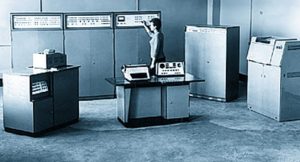Minsk-23 computer
The Minsk-23 was a mid-range business decimal computer (second generation) built from custom semiconductors, but its architecture and command system were completely different from the other Minsk-xx computers, essentially a clone of the corresponding member of the IBM 1400 computer family.
Use
n.a.
Beloiannisz Telecommunication Factory (BHG)
Structure
Central unit
Character-organized machine: 8 bpch
- control unit:
- logic circuits built from individual semiconductors (mainly П16А transistors)
- clock frequency: 250 kHz
- main store:
- 40 kch (20 kW) ferrite ring RAM (2*16 blocks, each with 100*100 ferrite rings)
- cycle time 13 μs
- fixed spreadsheets instead of calculators
- instead of channels, 8 data transmission interfaces to which control units (“switches”) can be connected
Periphery
- backup storage: 8 magnetic tape (½”) units (НМЛ-67); recording density 4 ch/mm
- external devices:
- control typewriter (CONSUL-254)
- punched card reader (УВВК-600), speed 600 cdpm
- punch card punch (ПМЭ-80), speed 100 cdpm
- punched tape reader (FS-1500), maximum speed 1500 chps
- punched tape punch (ПЛ-80/8, maximum speed 80 chps
- line printer (АЦПУ-128-2М), speed 380-420 lpm
Operation
The length of the instructions varies, but they always consist of an even number of characters – at least 4. Their structure:
- operation code (2 characters)
- title (4 characters)
- specifier (2 characters);
but they can be unaddressed, or have 1, 2, 3, or more addresses. (An example of the latter is the "clear flag bits in characters" instruction, which can have any number of addresses.) Special commands are used for searching and editing.
Character structure:
- 6 data bits, including 2 flag bits and a BCD character
- 2 check bits.
The first interface switch is built-in, while the others can be connected externally. Up to 8 external units can be connected to each switch, so the machine can handle up to 64 different peripheral devices simultaneously. Since the central unit controls the data transfer, the operation is interrupted during this process.
Decimal addition and subtraction of factors is done using calculation tables built into the protected area of the stock library. The exception is decimal-to-binary conversions.
Average operation speed 6 kips.
Program set
The programs used in practice were developed by users, according to their own goals.
Historical curiosities
Most of the circuit boards are interchangeable with those of the Minsk-22.
The instruction set brings the autocode language as close as possible to machine code, thus allowing for economical use of the main memory capacity and efficient development of various data structures and information processing systems.
Resources
General description: BHG Orion TRT Technical Bulletins, XVIII. vol. 1. no. 1972
Detailed description: Minsk 23 description
Detailed technical description: Minsk 23 (Russian)
Created: 2018.01.04. 13:54
Last modified: 2025.02.19. 17:03

